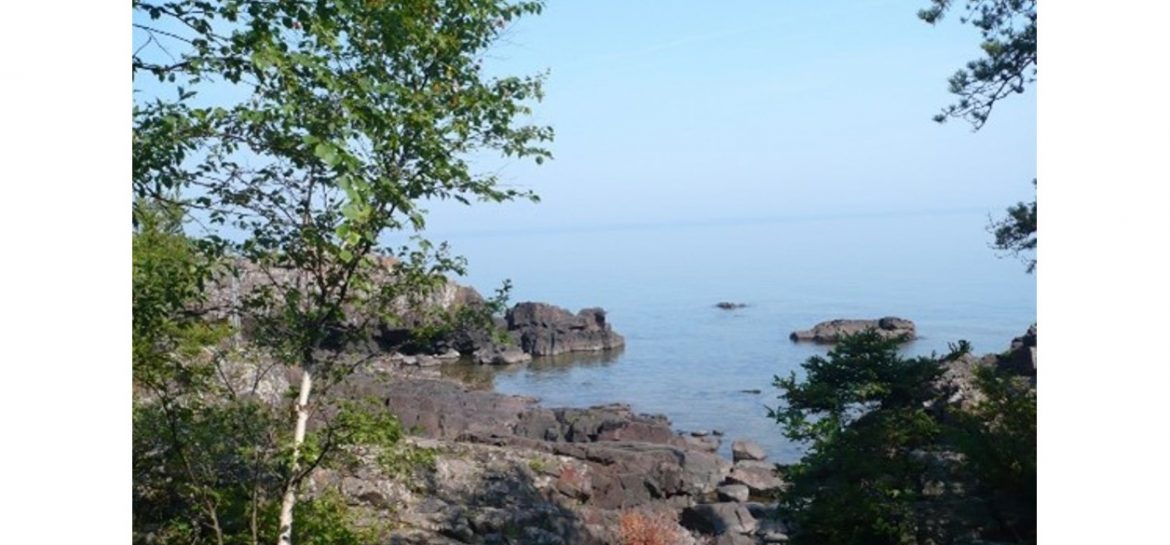
Close to 200 years after the first Cornish miners came to the wilderness of the Keweenaw peninsula on the shores of Lake Superior, seeking a better life than the lives they had left behind in Cornwall, a group of Cornish men and women of the twenty first century re-traced their footsteps and uncovered tales of hardship and heartache, perseverance and success, brought about through the experiences of their countrymen of long ago. David Oates brings us Part Two of this fascinating story.
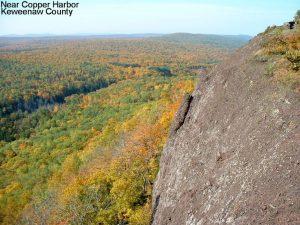 The wilderness of Keweenaw County in summer
The wilderness of Keweenaw County in summer
 The wilderness and Lake Superior in February
The wilderness and Lake Superior in February
On a hot August afternoon in 2001, two coachloads of Cornish folk from the Holman-Climax Male Voice Choir found themselves very near the end of Highway 41, a route that crosses the entire USA from Florida to its termination of the shores of Lake Superior. They stopped just off Highway 41 where, easily missed, lies the ghost town of Central, once home to many thousands of Cornish folk. All that now remains are a few of the wooden shacks built by the miners, now preserved as part of their Cornish heritage, and the Methodist Church still cherished by the descendants of those early miners.
Although made of wood – the most easily available building material – these early homes may well have represented a more comfortable home environment than the one they had left behind in Cornwall.
On that August day in 2001 the church was empty though the door was ajar. The Cornish visitors pushed the door open and the interior was filled with rays of sunlight, filled with the dust of ages. It was immediately apparent to those with any sense of the spiritual that those who worshipped here long ago were not so far away. Fanciful, may be, but my Methodist grandfather always maintained that there was only a thin veil between us and the other world. We all sat for a while and absorbed that overwhelming presence of those who had worshipped here, far from their native land. It was then thought appropriate that we should sing something in memory of those no longer here in physical form. The Musical Director of the choir picked up a hymn book from the lectern and it fell open at what was clearly a well-thumbed page. The hymn seemed as good as any we could choose and our Musical Director played the introduction to the hymn “All hail the power of Jesu’s name” to the tune “Diadem”. That sound of a church full of Cornish folk singing was like a dam breaking and the emotion passed around the church like waves and swelled to the point where everyone present, including those not given to expressing emotion, had tears rolling down their cheeks. If you know this tune you will also know it is well suited to the Cornish love of part singing, of runs and repeats. It was not until much later I discovered that this hymn and tune were at the height of popularity when this church was the spiritual centre of the mine and few services passed without it being sung – and it still is, each summer when the annual memorial service is held. I cannot hear that hymn now, twenty years on, without being moved.
So, what was the impact of these men and their families on this wilderness community many thousands of miles from home and with a climate of extremes and hardships. Driven mad by bugs in summer and with several hundred inches of snow every winter life here took some adapting to. They came for a better life and, by and large, it was but as in any mining community tragedy would not be far way either. There was certainly a dominant Methodist influence in these isolated communities but there were those, too, whose behavior was not driven by the tenets of Wesley’s teaching. We’ll look at both aspects in this piece. We shall also see that, although the Cornish had forsaken their homeland in pursuit of a better life, they made every effort to re-create the way of life they had left, here in the wilderness.
It is interesting to note, however, the actual perspective many of these immigrants had of Cornwall and the Cornish. Harry Tregilgas, of St Austell wrote that the emigrants who left Cornwall had a less romantic view of it as a place than we do today. For many of them, being Cornish was more important than being in Cornwall where there was a grim prospect of grinding poverty, ever-recurring mining depression and little prospect of relief, much of which was less onerous in what was a land of much opportunity in spite of the climatic extremes. This found resonance in a recollection in 2008 by Jack Treganowan of Eagle River who said: “My grandfather would have nothing to do with the old sod — never wrote home or would even talk of the old country. He just said all she did for us was to starve us. But he did hold on to his pasty, saffron buns and clotted cream, creamed salt cod.“
The early mines, of which Central was one, were “fissure” mines where the magma of ancient volcanic activity had left huge fissures underground in which were deposited immense amounts of pure, native copper that needed no refining other than removing it from the ground. Compared to the more complex ores that were eventually found to contain the bulk of the deposits in the Copper Country, these early mines were immensely productive but relatively short lived. When the fissure mines closed many other mines opened to exploit the more complex deposits of copper in the area – native copper, as in the fissure mines but in much smaller particles – as described in Part 1 – and one mining company bought up most of the existing mines to become the mighty Calumet and Hecla company – a company that prospered into the second half of the twentieth century. They again, employed thousands of Cornishmen but the thrust of this piece looks at the early fissure mines where there is much documentary evidence of the Cornish and their influence on the area. The Keweenaw peninsula is roughly the size of Cornwall and, like Cornwall, is littered with abandoned mine sites and much that was observed of specific mines can be said of most of the others.
Situated in the wilderness on the shores of Lake Superior, mines like Central certainly needed to be relatively self-sufficient – most supplies arrived by ship and the long, ice-bound winter could mean essentials sometimes being in short supply. The settlement of Central therefore contained all the essentials for a small town to exist. Its remoteness, too, meant the transplanting of a Cornish way of life to the settlement could occur with few other influences to dilute the mix!
In addition to all the specialized equipment and machines required to operate a large mine there was accommodation for the workers, a church, a schoolhouse, a general store, a doctor’s office and a post office. There was a Masonic Lodge and lodges of other fraternal organisations beloved by the Cornish miner. A daily stagecoach, however, travelled between the mine and the town of Calumet – a place that became the focus of a number of social or competitive activities between the various mines.
The most impressive extant building at Central, however, is that imposing wooden Methodist church, built with a tower. Records show that the miners were Methodist to a man, hence this Methodist Church, but the design here with a tower complete with wooden battlements suggests a hankering for what would have been a common sight in every Cornish parish, the church of England with a pedigree stretching back through the centuries.
 Central Methodist Church on the Keweenaw Peninsula
Central Methodist Church on the Keweenaw Peninsula
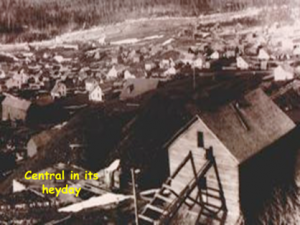 Central was a rich mine employing hundreds of Cornishmen, in a community of over 1,300, who lived on the site in a town with many facilities they wouldn’t have seen in Cornwall. Indeed, in many of the mines in the area the need to attract the skilled Cornish was such that accommodation was often provided – bunkhouses for single men and cabins for families. Central Mine had an active life of forty-five years but by the start of the twentieth century it was abandoned. However, in 1906 those who had lived there decided to preserve the church and hold an annual service each July and their descendants carry this on the present day.
Central was a rich mine employing hundreds of Cornishmen, in a community of over 1,300, who lived on the site in a town with many facilities they wouldn’t have seen in Cornwall. Indeed, in many of the mines in the area the need to attract the skilled Cornish was such that accommodation was often provided – bunkhouses for single men and cabins for families. Central Mine had an active life of forty-five years but by the start of the twentieth century it was abandoned. However, in 1906 those who had lived there decided to preserve the church and hold an annual service each July and their descendants carry this on the present day.
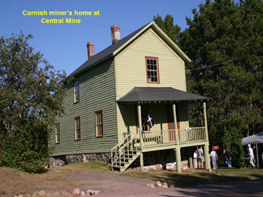
The Cornish predominance at Central Mine was such that native born Americans visiting the mine often said they needed an interpreter to fully understand what the Cornish were saying! Methodists were predominant and with them they brought their culture – many mines had their own band – in the case of Central, the Central Cornet Brass band. Anecdotal evidence tells us that they had no set uniform and were a rather nondescript group as many of the members would wear the uniform they brought with them from Cornwall, from the band they belonged to there. If a member left, someone with musical promise was recruited and they were told to “blaw easy an keep yer fingers movin’” until they acquired the necessary skill!
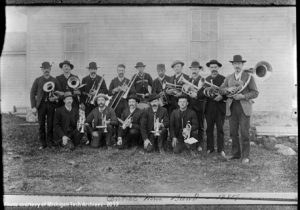 Central Cornet Brass
Central Cornet Brass
If brass bands were important to these Cornish immigrants, then singing was more so. It had its roots in the Methodist Church but went far beyond the confines of the building. Miners sang on their way to work, they sang underground – almost exclusively the powerful hymns they learned from the traditions of Wesley. Such was the enthusiasm for singing that there was a competition for choirs each year in the main town of Calumet. Whether they were purely male or mixed choirs we do not know but it, again, emphasized the centrality of music and the Methodist influence. A contemporary account, from Angus Murdoch in his book, “Copper Boom” tells us much: “Next to talking, the Cousin Jack loved to sing. Few had formal training but volume was considered a compensation to polish. They sang on their way to work and blended their song as the man car took them down the shaft. …Until you have heard Cornish singers, their rich baritones echoing from the bluff back of Central, and seen them stand bowed before an open grave in a mine cemetery, you don’t know how truly beautiful and dignified the burial service can be.”
He confirms the dominance of Methodism in their daily lives too, and their attraction to non-conformist philosophies: “The Cornish preferred hell-fire and brimstone Methodism to the more formalised religion of the Church of England. No chanting and ceremonial rites for Cousin Jack. Whenever original ideas of the hereafter occurred, he liked to stand right up in church and air them. He was highly articulate, if uneducated, and took turns with fellow Wesleyans in preaching the weekly sermons.”
There were ministers allocated to these areas but, as in Cornwall, the bulk of the services were taken by local preachers. The minister would have been allocated up to six churches on the respective mining camps but given the distances and terrain involved the local man often saved the day. These local preachers were invariably miners by day but possessed concordances and commentaries and had a great knowledge of the scriptures and how they felt those scriptures should apply to daily life. It appears that in the mine settlements these local preachers were held in the deepest respect and often preferred to the minister. Most of these refused to use notes and espoused a freedom of gestures and movement! There were times, however, when one of these worthies would lose his train of thought and if silence prevailed, someone would strike up a hymn and by its conclusion the train of thought would be back on track. If the allotted preacher did not turn up because of personal circumstances or weather, it was common after a period of waiting, for someone to shout, “Brother Nicky (or whoever) will preach”. After a short period of modesty, “Brother Nicky” would ascend the platform and take the service. Of course, “Brother Nicky” would be a long established and learned member of the congregation!
Although the Methodist Church showed the dominance of the non-conformist faith, there was also a Catholic Church in the township. Many of those adherents were Irish and there was often strife between the two communities – Celtic both but the divide between Methodism and Catholicism in those early days of this mining field was great. This was exacerbated by the fact that the Cornish invariably held positions of responsibility and skill whereas the Irish were often in a labouring capacity. It was often noted that for many of the immigrants from both Ireland and Scandinavia, a mine was an intimidating and hostile environment whereas for the Cornish it was a familiar and well-known situation.
Death and injury was part and parcel of mining and they were sometimes caught unaware by the fierce winters. The winters brought some incredibly hard times and in 1864, when complex geology forced several mines to close down for the winter, many Cornishmen and their families were literally put out on the streets. They had no option but to set out, on foot, in mid-January for the settlement of Green Bay, two hundred miles away. They were dressed in clothes more suited to Cornwall and very few survived. In the spring the bodies of those the wolves hadn’t eaten were revealed beneath the melting snow.
We have already seen that we have to rely to some extent on contemporary observations of the Cornish in the Keweenaw and they come from two main sources – “Copper Boom” by Angus Murdoch, already referred to, and “Copper Country Journal” by Henry Hobart. They give strikingly different observations of the Cornish but it must be said that Henry Hobart, who was the teacher in the community at the Cliff Mine, was from the more civilized Vermont and he seems to equate the Cornish with the African Americans in slavery at the time he wrote, and those observations are far from complimentary. He was, however, a great supporter of the Temperance movement espoused by the Methodist and he gives praise to their efforts to bring order to what he saw as a somewhat lawless society – which it probably was when the Keweenaw was on the then frontier of the states and territories that became the USA.
Murdoch’s book, however, is a fairly definitive history of the copper boom in which he records the Cornish culture and contribution to daily life with reasonable accuracy. They both, however, give a fascinating insight into the period and the role the Cornish played.
For the rest of the nineteenth and early twentieth century, the Cornish flooded into this area, driven by both necessity as mines closed at home and the promise of a better life in the New World. They were so successful that cousins, brothers, sons and uncles followed the first comers and they were quickly hired by mine owners who knew their worth. Other nationalities, notably Scandinavians and Irish came as well but the Cornish always held the plum jobs due to their vast experience. Angus Murdoch sums up their influence by noting that they insisted on working independently as they had at home: “An independent breed, they worked as they had at home – ‘tributing’ – where they were not ordinary employees but contracted to work a measured portion of a particular part of the mine. If the ground was poor, his pay was small but if it was rich he and his maid could eat roast beef!”
 A “pare” of men beating a hole in the Copper Country.
A “pare” of men beating a hole in the Copper Country.
The community at Central Mine was predominantly Cornish as was the work force in another significant fissure mine, the Cliff Mine – so called as the early exploration take the form of levels driven into a cliff-side. Much of what we have learned from Central Mine can also be said of the Cliff Mine community – and for the settlements at numerous other mines in the Keweenaw.
 Cliff Mine in its heyday
Cliff Mine in its heyday
 All that remains of Cliff Mine today
All that remains of Cliff Mine today
The schoolmaster at the Cliff Mine community in the early 1860s, Henry Hobart, records observations about the Cornish community in his journal. Although he lodged with a Cornish family called Penberthy, from Marazion, his opinion of the Cornish was not high. He was from a rather genteel background in Vermont though and was clearly shocked by what he saw as the rough way of living in a frontier mining camp. His attitudes to black people also echo the general attitudes of the period although he supported the Union cause in the Civil War. His almost virulent attitude to the Cornish is hinted at in his observations of Cousin Jack on the boat to the Keweenaw:
Extract from “Copper Country Journal” by Henry Hobart:
“Cousin Jack coming from below on the boat, took his seat at the table with others at dinner time. Among the luxuries was some green corn boiled on the cob. Cousin Jack took it for peas and taking an ear soon ate the corn off leaving the cob bare. He then addresses the waiter thus: “Black man, put some more peas on my stick, you. Darnee, I’ve ate them all.”
He was no more complimentary about the Penberthy family with whom he lodged although their standing in the community was several social scales up from the bottom. However, he found their way of living far different from his quite privileged upbringing. Were he in possession of the conditions applicable in a Cornish domestic setting at that time – when the American Civil War was raging – he may have concluded the immigrants had vastly improved their conditions and social standing. Here’s an observation about his lodgings:
Extract from “Copper Country Journal” by Henry Hobart on Cornish domestic life:
“I could never enjoy Cornish living. Wipe the knives and forks on the towel, wash the plates in the wash dish and perhaps in the same water that some nasty little urchin had used. The bread is molded on a board that looks like a stable window. Oh, horrors! I feel like crying out at times.”
His adherence to temperance certainly led to some admiration of the Methodist society but the tendency of the Cornish in some situations to have read widely and be used to a discourse on a variety of subjects, he saw in a far different and less complimentary light:
Extract from “Copper Country Journal” by Henry Hobart on the Cornish generally:
“The self-conceit, pride and affectation of the young men of this place who are as ignorant as jackasses and full blood Cornish, of course. How disgusting to have them come around and in a pompous style and without a request explain something that they know nothing about and say they showed it was a thing that I knew and was able to explain long ago. A person must keep silent in my position but it is hard to do it sometimes.”
As an interesting footnote Hobart records that the Cornish showed little interest in, or support for, either side in the Civil War. He describes them as “English” through and through, unwilling and disinterested in any thought of enlisting. The union army was in the area, however and as they didn’t live in enlightened times, their fort served, in some cases, to protect the Objibway native Americans from those seeking to exploit the area rather than the other way round. Fort Wilkins, near Central Mine, was fully garrisoned during the Civil War as they feared the British would nip over from Canada and annexe this rich copper producing area. A considerable number of Cornish miners did actually enlist in the Union Army, took the first month’s pay, went to Detroit and absconded to Canada!
All that remains of Cliff Mine now are a few tumbled ruins but, deep in the woods is the cemetery where they laid their folk to rest, barely recognisable as such now but with poignant reminders of those long gone on worn stones:
 Isabella, Oldest daughter of Harlow and Jane Everett 1864
Isabella, Oldest daughter of Harlow and Jane Everett 1864
The evidence of the Methodist influence brought to the area by the Cornish is clear and indisputable, It is equally clear, however, that not all the immigrants for Cornwall espoused either the faith or the temperance movement and there are well documented instances of both drunkenness and violence ascribed to some of the Cornish. This was particularly true where the Cornish and the Irish came into close contact as, strangely for two Celtic peoples, they loathed the sight of one another. In later years this difference brought about by the clash between Catholicism and the Nonconformist church abated through intermarriage and a tolerance of the views of others. There were Cornish bars and Irish bars but the consumption of alcohol led to one conclusion – should they meet, violence was often the result. Most consumed the local hooch, known as “forty rod” – it was said the fumes alone from this concoction would down your grandmother at a distances of forty rods!
(In the depths of winter when supplies were scarce, it is said that “forty rod” became weaker and weaker as water was added to eke out supplies!)
We have many examples of this lawlessness caused by alcohol but one serves to both illustrate and amuse. It concerns one Jemmie Tresize, a man of great stature and strength who was said to be able to load a kibble faster than ten men working together. He would labour all week and then on a Sunday imbibe prodigious quantities of “forty rod” after which he would take on four or five men, invariably Irish origin. This happened so often that there was a standing order that when Jemmie showed signs of intoxication he was to be locked up in the jail at Eagle River.
(I have seen the jail in Eagle River and it is no more than a wooden cabin with bars on the window)
This did not prove successful with a man of such strength and stature so the councilmen sent to Detroit for a ball of solid iron, weighing, it is said, 200lbs, to which Jemmie was shackled when inebriated and locked in a yard to sober up. A collective sigh of relief was breathed until someone passing a Cornish bar the next Sunday night saw Jemmie, standing at the bar, shouting defiance to every Irishman in the district with a glass of “forty rod” in one hand and the 200lb ball in the other!
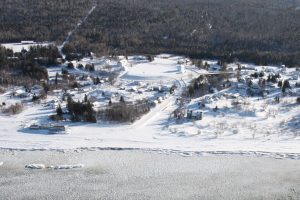 Eagle River in winter where Jemmie Tresize went on the rampage!
Eagle River in winter where Jemmie Tresize went on the rampage!
Early fissure mines and some lawlessness on what was then the frontier gave way in the fullness of time to more settled times and even greater riches.
The early mines were very rich but their geology meant they became exhausted at a fairly early stage. A much different geological environment, though, gave rise to what became one of the most celebrated mines in the world – the Calumet and Hecla Mine, around which grew the town of Calumet with its satellites, Red Jacket and Yellow Jacket. Calumet today is a sleepy town in rural America with a population of around 1,000 but in its heyday had a population of 66,000, many of whom were of Cornish origins.
The Calumet and Hecla Mine was a huge undertaking eventually encompassing many of the smaller mines in the area and employed over 6,000 men at its peak production. There were years of uncertainty but it produced huge profits over its life-time of over 100 years. In that time the mines of this small area paid dividends of over $300,000,000 – an unbelievable sum then, and in our terms, today.
Calumet and Hecla had 21 shafts and went to a depth of over 6,000 feet.
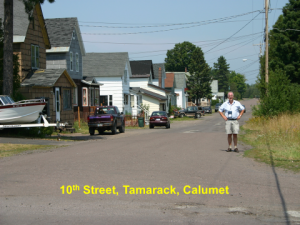 David Oates outside a company house in Calumet where an ancestor lived at the beginning of the twentieth century
David Oates outside a company house in Calumet where an ancestor lived at the beginning of the twentieth century
The mining company provided total care for its employees – they built houses, provided electricity and heating, they built a hospital for their employees and their families, built a large library, and provided land for churches. But with all this social care and prosperity the Cornish kept their roots – their singing, their bands and, even a cricket league!
 Mine cricket team in the Keweenaw – sadly it did not persist in the US as they found it as inexplicable as many of us still do!
Mine cricket team in the Keweenaw – sadly it did not persist in the US as they found it as inexplicable as many of us still do!
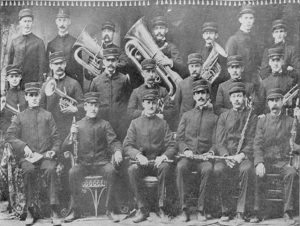 Calumet and Hecla band – a far cry from the nondescript appearance of those earlier bands
Calumet and Hecla band – a far cry from the nondescript appearance of those earlier bands
In spite of their benevolent approach to their workers the Calumet and Hecla Company was never keen on union activity and had broken previous strikes – one notably over the introduction of the one man drill rather than a group of three miners hand-drilling – a traditional Cornish method. However, the mine shut down rather than submit to union demands in 1968 and when no solution was forthcoming, turned off the pumps in 1970, bringing to a close an era of unprecedented wealth and development. The shafts are capped and the wilderness has taken back the land.
A look at the phone book of the area today shows the Cornish are still there – Medlyn – Quick – Trevorrow – Noall – Moyle – Hollow – Davis – Blewett – Treganowan – Menhennet – Vincent – Lanyon – Penberthy – Lutey – Kitto – Rosemergy – Richards – Trevithick – Dawe – descendants of those intrepid immigrants, forced by necessity to leave Cornwall. They left but took Cornwall with them, and that culture is still going strong. Here’s what a few of them had to say in 2008:
Tom Ellis, Eagle Harbour, 2008:
“My father worked for the Harvey family, tending horses. After he and my mother were married, an uncle gave them passage to the US as a wedding present. When they got to Chicago, they decided to go to Ishpeming to see Uncle Henry. They were headed for California but ran out of money. Uncle Henry took Dad to the mine and he got a job there. Listening to my father was a pleasure. His humour was interesting and he never lost the accent. He and my mother went back to Cornwall twice. They made a good home in Negaunee and raised six children. I don’t think he ever regretted coming here.”
Greta Penrose Erm, Calumet, 2008:
“They spoke about Cornwall very often. I grew up hearing stories about the clay mines in the St. Austell area and the butcher shop owned by the Penrose family in Penzance. When I first went to Cornwall I felt as though I had been there before because my grandparents’ stories had been so real.”
Cyrus Hollow, Calumet, 2008:
“Daniel Hollow came to America as a teenager to work with his father in the mines. He fought in WWI and became a citizen. He married Margaret Blewett after WWI. They had 2 children, Cyrus Hollow and Phyllis Hollow Pizzi. Daniel and Margaret lived on Sixth St. in what was then Tamarack Mills. Daniel Hollow was a foreman in the reclamation plant.”
The Upper Peninsula today must surely rival Cornwall in its pasty production. There are two pasty trails for the tourist, each over two hundred miles long and at each of the many recommended stops there will be at least one pasty shop. A word of warning though. The influence of Scandinavians in the mining community has led – horror of horrors – to many pasties containing carrots!
Also, each month, those of Cornish descent have a Zoom meeting with friends in Camborne and district and any interested are welcome to participate.
References:
Friends in Calumet, Eagle River and Eagle Harbor
Cornish in Michigan – Russell Magnaghi
Cradle to Grave – Larry Lankton
Central Mine – a Ghost Town –Clarence Monette
Copper Boom – Angus Murdoch
Copper Country Journal – Henry Hobart
 David Oates is a Cornish bard who has published a history of Troon, entitled “Echoes of an Age”, a guide to Godrevy and Gwithian, “Walk the hidden ways” and a slim volume of his own verse, “Poems from the far west”. His unpublished work includes a reflection on a Cornish childhood, “What time do they close the gates, Mister?” and a fictionalised story for young people based on the extant life of St Gwinear, with the working title, “The son of a king”. David is working on another guide in the “Walk the hidden ways” series, entitled “Hard Rock country”.
David Oates is a Cornish bard who has published a history of Troon, entitled “Echoes of an Age”, a guide to Godrevy and Gwithian, “Walk the hidden ways” and a slim volume of his own verse, “Poems from the far west”. His unpublished work includes a reflection on a Cornish childhood, “What time do they close the gates, Mister?” and a fictionalised story for young people based on the extant life of St Gwinear, with the working title, “The son of a king”. David is working on another guide in the “Walk the hidden ways” series, entitled “Hard Rock country”.
David is a tenor singer with the well-known group, Proper Job based in mid- Cornwall and has collaborated with Portreath musician, Alice Allsworth, to write the lyrics for a number of songs about Cornwall and the Cornish.
